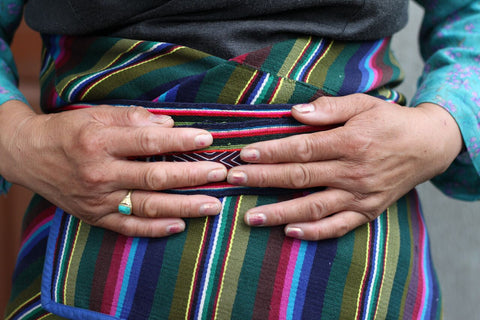Your Cart is Empty
Free Shipping on all orders in the US!
Free Shipping on all orders in the US!
January 24, 2018 2 min read
The "pangden" is the apron worn by many Tibetan and Ethnic Tibetan women on the front of their dress.

They also wear similar, colorfully striped aprons around their waists and backside. Every different group of people has a unique design of colors and patterns for their pangdens, and an educated observer may even be able to differentiate between the various Himalayan people by recognizing the different unique patterns and coloration of pangden. Our products reflect these unique and varied colors.
These different types of aprons have individual names in the local languages, and they are all highly practical as well as ornamental. The woman's apron functions as so many different things in the home and field work. The pangdens provide warmth, a ready cloth for picking up hot pans from the fire or wiping clean her baby's face, as well as a place to secure items like her sewing needle or flint.
Beyond a merely practical piece of clothing, the pangden also reflects the beautiful aesthetics of the places these women live. The snow white, the flowery reds and purples, the turquoise blue, and the deep tones of green, indigo, and black all provide a glimpse into the majesty of this part of the world.
Another fascinating aspect of the pangden is how it often signifies that a woman is married. Often young women desire to wear a beautiful pangden as a symbol of their marriage. Not every group uses pangdens to show marriage, but often you can see that a Himalayan woman is married simply by observing the pangden she wears on the front of her dress. Either way, the pangdens and various other striped aprons are special and unique to the Tibetan and Ethnic Tibetan peoples.
Pangden Making:
Pangden making reflects the land and culture of the people. The wool traditionally used comes from the goats herded in the Himalayas. This wool has to be spun and dyed before being loaded onto spindles.

Weavers then spend hours at a large, handmade, wooden loom. They move the spindles of color back and forth, changing between colors, tightening down, and sorting the pattern of colors until the final length of textile is ready to be made into a pangden.

Mothers pass these skills to their daughters, generation after generation. The women of a particular cultural group show the beauty and skill of their people through the pangdens and other textiles they wear.
The White Yak is privileged to be able to promote this amazing tradition. We hope our products and company honor these wonderful women and people.
FOR SNEEK PEAKS, EXCLUSIVES AND MORE!